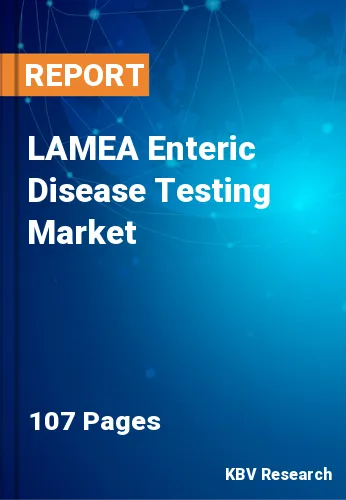The Latin America, Middle East and Africa Enteric Disease Testing Market would witness market growth of 6.0% CAGR during the forecast period (2023-2029).
The untapped market potential in developing nations offers a significant chance for healthcare enterprises to create cutting-edge and affordable testing solutions to meet the unmet needs of the populace. The rise in the popularity of enteric disease testing, increased awareness of the diagnosis of enteric disease testing in emerging economies, a rise in disposable income, an increase in funding, and the discovery and development of efficient enteric disease testing products are other factors that contribute to the industry's expansion.
Innovations in technology and government backing in emerging economies are key market drivers. The market's expansion is also anticipated to be fueled by the expanding demand for early diagnostics. The culture approach, which required expert personnel and took time, formed the foundation of the conventional diagnosis process for enteric infections. Over the past ten years, the market has undergone a revolution owing to the advent of molecular diagnostics as well as additional diagnostic technologies. The demand for early diagnosis of these disorders is anticipated to increase due to the rising mortality rate brought on by these conditions and the affordability of technologically sophisticated diagnostic devices.
Brazil is projected to offer significant opportunities for growth in the near future. The economic and political stability in Brazil has resulted in favorable economic growth. In addition, implementing healthcare reforms, including the Unified Health System (SUS), has provided cost-free healthcare amenities to individuals across all levels. This has been achieved without any additional charges being levied on the beneficiaries. The SUS comprises a blend of healthcare services from both the public and private sectors, as well as supplementary sources. The market is being boosted by supportive government initiatives, including the nation's collaboration on biomedical research aimed at accelerating research and development in diagnosing and treating infectious diseases. These factors are propelling the regional market's growth significantly.
The Brazil market dominated the LAMEA Enteric Disease Testing Market by Country 2022, and would continue to be a dominant market till 2029; thereby, achieving a market value of $85.3 million by 2029. The Argentina market is anticipated to grow at a CAGR of 6.6% during (2023 - 2029). Additionally, The UAE market would showcase a CAGR of 5.7% during (2023 - 2029).
Based on End User, the market is segmented into Hospital Laboratories, Pharmaceutical & Biotechnology Companies, and Academic & Research Institutes. Based on Disease Type, the market is segmented into Bacterial, Viral and Parasitic. Based on Product Type, the market is segmented into Reagents & Consumables and Equipment. Based on Technique, the market is segmented into Immunodiagnostics and Molecular Diagnostics. Based on countries, the market is segmented into Brazil, Argentina, UAE, Saudi Arabia, South Africa, Nigeria, and Rest of LAMEA.
Free Valuable Insights: The Worldwide Enteric Disease Testing Market is Projected to reach USD 4.6 Billion by 2029, at a CAGR of 3.2%
The market research report covers the analysis of key stakeholders of the market. Key companies profiled in the report include Merck KGaA, Thermo Fisher Scientific, Inc., SGS S.A., Eurofins Scientific SE, Bureau Veritas S.A., Intertek Group PLC, TÜV Nord Group, PerkinElmer, Inc., Becton, Dickinson and Company and Neogen Corporation.
By End User
By Disease Type
By Product Type
By Technique
By Country
Our team of dedicated experts can provide you with attractive expansion opportunities for your business.

